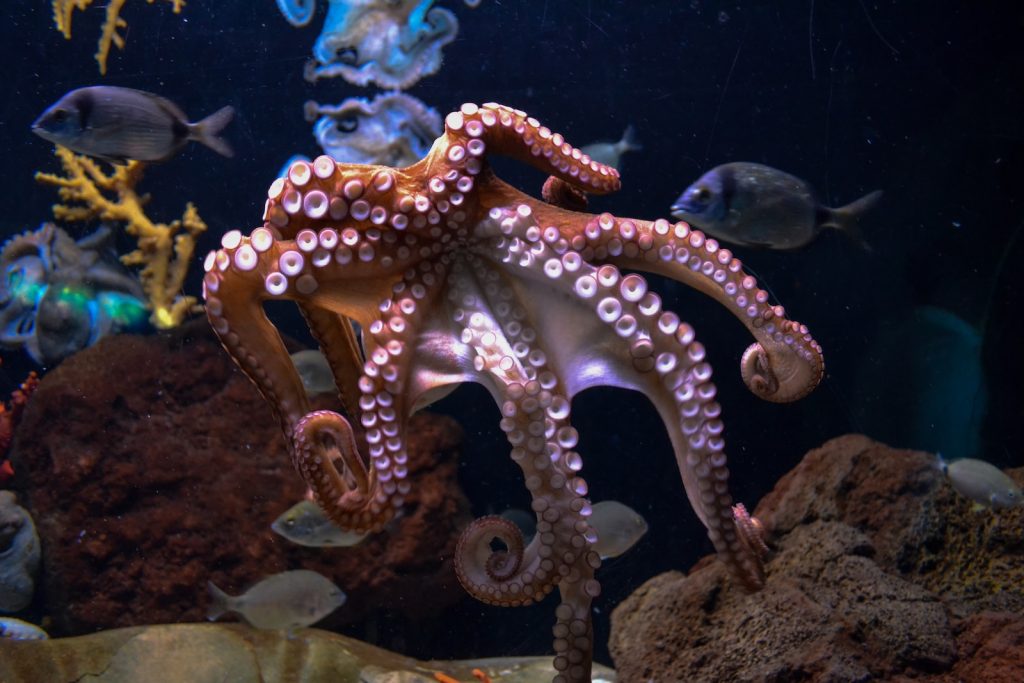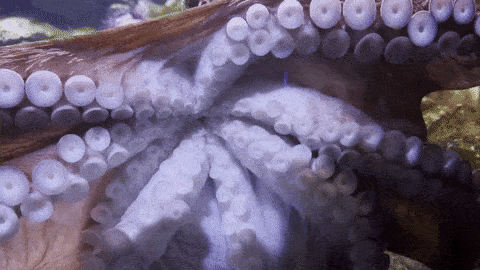Do Octopus Have Beaks?
Overview of Octopuses
Octopuses are fascinating creatures that belong to the family Octopodidae. They are known for their eight arms and their ability to change color and texture to camouflage themselves. They are invertebrates that belong to the order Octopoda, which includes around 300 different species.

Physical Characteristics
Octopuses have a distinct anatomy that sets them apart from other animals. They have eight arms that are lined with suckers, which they use to grip onto objects and capture prey. They also have a mantle, which is the main part of their body, and a head that contains their eyes and beak. Their eyes are large and well-developed, allowing them to see in a wide range of light conditions. Their beaks are made of chitin and are located at the base of their arms. They use their beaks to break open the shells of crustaceans and mollusks, which are their primary food sources. Octopuses come in a variety of sizes, with the largest being the giant Pacific octopus, which can weigh up to 600 pounds.
Behavior
Octopuses are known for their intelligent behavior and problem-solving abilities. They have a highly developed nervous system, with neurons located throughout their body. This allows them to process information quickly and respond to their environment in a variety of ways. Octopuses are solitary animals that hunt and mate alone. They use their camouflage abilities to sneak up on prey and their jet propulsion system to swim away from danger. They also have a complex digestive system that allows them to break down food quickly. In terms of reproduction, male octopuses have a specialized arm called a hectocotylus that they use to transfer sperm to the female. Female octopuses lay their eggs in a den and guard them until they hatch.
Do Octopuses Have Beaks?
Octopuses are fascinating creatures that have beaks. Beaks are hard, chitinous structures that are found in the mouths of cephalopods, including octopuses. They are used to break down and eat prey, and they are similar in function to the jaws of other animals. Beaks are made of a tough, durable material that can withstand the forces of biting and grinding.

What are Beaks?
Beaks are hard, chitinous structures that are found in the mouths of cephalopods, including octopuses. They are used to break down and eat prey, and they are similar in function to the jaws of other animals. Beaks are made of a tough, durable material that can withstand the forces of biting and grinding.
How Do Octopuses Use Their Beaks?
Octopuses use their beaks to break down the hard exoskeletons of their prey. They are able to bite through shells, crab claws, and other tough materials with ease. The beak is located in the center of the octopus’s arms, and it is used to grasp and manipulate food.
The Beak’s Role in Hunting and Feeding
Octopuses use a combination of their radula (a tongue-like organ with rough barbs) and salivary papillae to drill into or crack open hard shells. Once the shell is breached, the beak comes into play, cutting apart softer food like fish into manageable chunks. This method of feeding is not just about brute force; it involves a sophisticated use of various anatomical tools. For a deeper understanding of cephalopod feeding mechanisms, check out Cephalopod Research.
Validation of Beak Increments
Studies have shown that beaks can be used to determine the age of octopuses. By counting the number of increments in the beak, scientists can estimate the age of the octopus. This method has been validated for Octopus vulgaris and Octopus maya.
Octopus Beaks and Prey
Octopuses have beaks that they use to break down the tough exoskeletons of prey before ingestion. They are carnivorous and feed on a variety of prey, including clams, crustaceans, and other cephalopods. They are known to be opportunistic feeders and will consume whatever prey is available. They have also been observed preying on fish, crabs, and mollusks. Octopuses use their beaks to break down the exoskeletons of prey before ingestion. They are also equipped with venomous saliva that can be used to immobilize prey. Some species of octopus are also known to use ink as a defense mechanism to confuse predators. Octopuses are dangerous predators and their beaks are a testament to their hunting abilities. They are able to consume prey that is much larger than themselves, thanks to their powerful beaks and unique feeding strategies. Overall, the beaks of octopuses are an essential part of their anatomy and play a critical role in their survival.
Octopus Beaks and Anatomy
Octopuses have a unique feeding structure known as a beak, which is located at the base of their arms. The beak is made of chitin, a hard, protein-based material, and is used to crush and tear apart the octopus’s prey. The beak is divided into two parts: the upper and lower beaks. The upper beak is larger and more curved than the lower beak, and both beaks are sharp and pointed. The anatomy of the beaks varies among different species of octopuses. For example, a comparative study of the morphology and anatomy of octopuses of the family Octopodidae found that lower beak characters can be used at the generic level to differentiate between species. However, anatomical characters are not always applicable to identify octopus species. Octopuses have eight arms, each of which is lined with suckers. The suckers are used for grasping and holding onto prey, as well as for locomotion. The suckers are located on the underside of the arms and are surrounded by a ring of muscle that allows the octopus to control their grip strength. The arms themselves are highly flexible and can be moved in any direction. The anatomy of the arms includes a complex network of muscles and nerves that allow the octopus to control their movements with incredible precision. In addition to their beaks and arms, octopuses also have a radula, which is a ribbon-like structure covered in tiny teeth. The radula is used to scrape and shred food before it is passed into the mouth. The mouth of the octopus is located at the center of its arms and is surrounded by a structure known as the salivary papilla. The salivary papilla secretes saliva into the mouth, which helps to break down the food before it is swallowed.
Octopus Beaks and Evolution
The octopus beak is a hard, chitinous structure that has evolved over millions of years. The earliest known octopuses had a hard, toothed tongue called a radula, which they used to scrape food off rocks and other surfaces. Over time, as octopuses evolved to become more active predators, the radula was replaced by the beak. The octopus beak is similar in structure and function to the beaks of birds and the jaws of mammals, despite the fact that octopuses are more closely related to snails and clams than to vertebrates. This convergence is thought to be the result of similar selective pressures on different lineages of animals, such as the need to crush hard shells or defend against predators. The octopus beak is controlled by a complex network of neurons that are part of the animal’s nervous system. These neurons are responsible for coordinating the movement of the mandibles and sensing the texture and hardness of the prey. The study of octopus beaks and the nervous system that controls them is an active area of research, with applications in fields such as robotics and materials science.
Frequently Asked Questions
What is the structure of an octopus beak?
Octopus beaks are hard, chitinous structures located in the center of their arms. They are made up of two parts, the upper and lower mandibles, which are used to crush and tear prey. The beak is similar in structure to a bird’s beak, but it is much harder and more durable.
How strong is an octopus beak?
Octopus beaks are incredibly strong and can exert a force of up to 200 pounds per square inch. This allows them to crush the shells of crustaceans and mollusks, which are their primary prey.
Can an octopus beak cause harm to humans?
Yes, octopus beaks can cause harm to humans. While octopuses are generally not aggressive towards humans, they may bite if they feel threatened. Their beaks can cause puncture wounds, which can become infected if not treated promptly.
How does an octopus use its beak?
Octopuses use their beaks to catch and eat prey. They will grab their prey with their arms and then use their beak to crush and tear it apart. They may also use their beak to defend themselves if they feel threatened.
What other animals have beaks similar to octopuses?
Squids and cuttlefish also have beaks that are similar in structure to those of octopuses. These beaks are used for the same purposes, to catch and eat prey.
How does the beak of a squid compare to that of an octopus?
The beak of a squid is similar in structure to that of an octopus, but it is usually smaller and less powerful. Squids are also more likely to use their tentacles to capture prey, while octopuses rely more on their arms.



